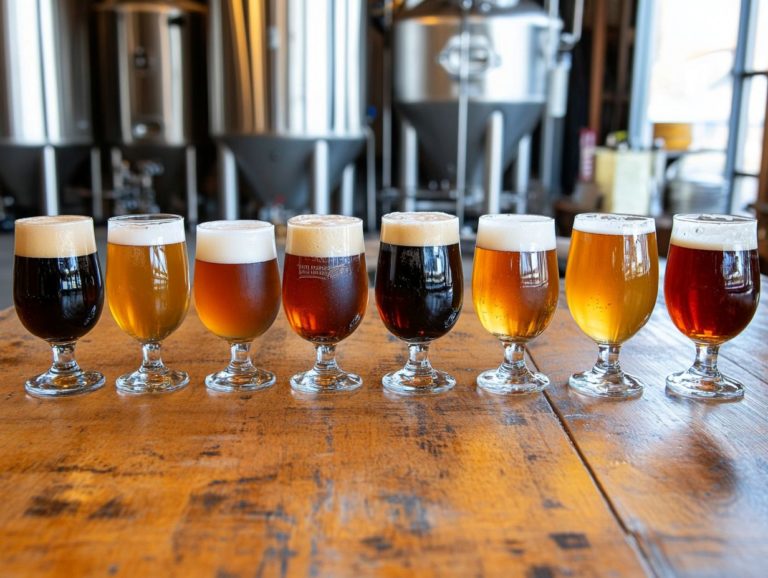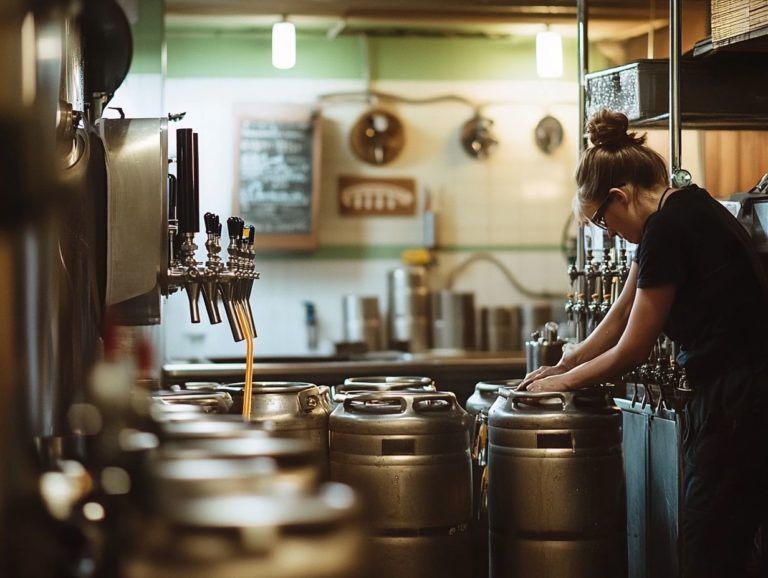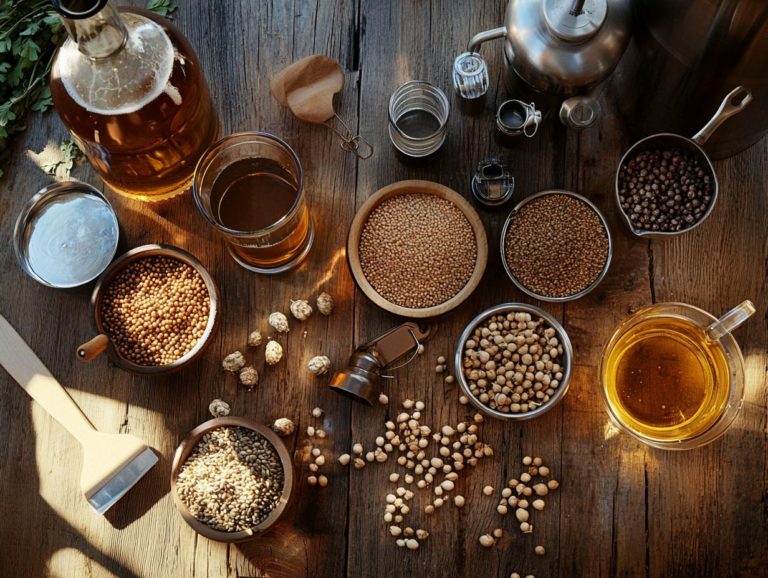What Are the Most Common Home Brewing Myths?
Homebrewing has experienced a remarkable surge in popularity, enchanting both casual drinkers and devoted beer aficionados alike. Homebrewing has captivated a diverse audience, inviting everyone to join in on the fun!
Unfortunately, misconceptions often cast a shadow over the joy of crafting your own brews. Fears about legality and doubts concerning quality can deter many enthusiastic individuals from diving into this rewarding hobby. Concerns about trub, the leftover sediment after fermentation, and hop residue can intimidate beginners.
This article seeks to dispel the most prevalent myths surrounding homebrewing, empowering you to embrace the brewing process with both confidence and creativity. From understanding temperature control to mastering secondary fermentation, we’ve got you covered.
Whether you re a curious novice or a seasoned enthusiast, there s exciting knowledge here for everyone to savor! Learn about batch sparging and brew-in-a-bag techniques that simplify the process.
Contents
- Key Takeaways:
- What is Home Brewing?
- What Are the Most Common Myths About Home Brewing?
- Common Myths About Home Brewing
- Myth 1: It’s Illegal to Brew Your Own Beer at Home
- Myth 2: You Need Expensive Equipment to Brew Beer at Home
- Myth 3: Brewing Beer at Home is Time-Consuming and Difficult
- Myth 4: Home Brewed Beer Always Tastes Bad
- Myth 5: Home Brewing is Only for Beer Enthusiasts
- Myth 6: You Can’t Make High-Quality Beer at Home
- Myth 7: Home Brewing is Cheaper Than Buying Beer
- Myth 8: You Can’t Experiment with Flavors and Styles When Home Brewing
- Myth 9: Home Brewing is Only for Men
- Myth 10: You Need to Be a Chemist to Understand the Brewing Process
- Frequently Asked Questions
- What Are the Most Common Home Brewing Myths?
- Are darker beers stronger than lighter ones?
- Does adding more hops make a beer more bitter?
- Is it necessary to boil the entire batch of beer?
- Can you use any type of water for home brewing?
- Is it necessary to use a secondary fermentation vessel?
- Can you use any type of sugar for fermentation?
Key Takeaways:
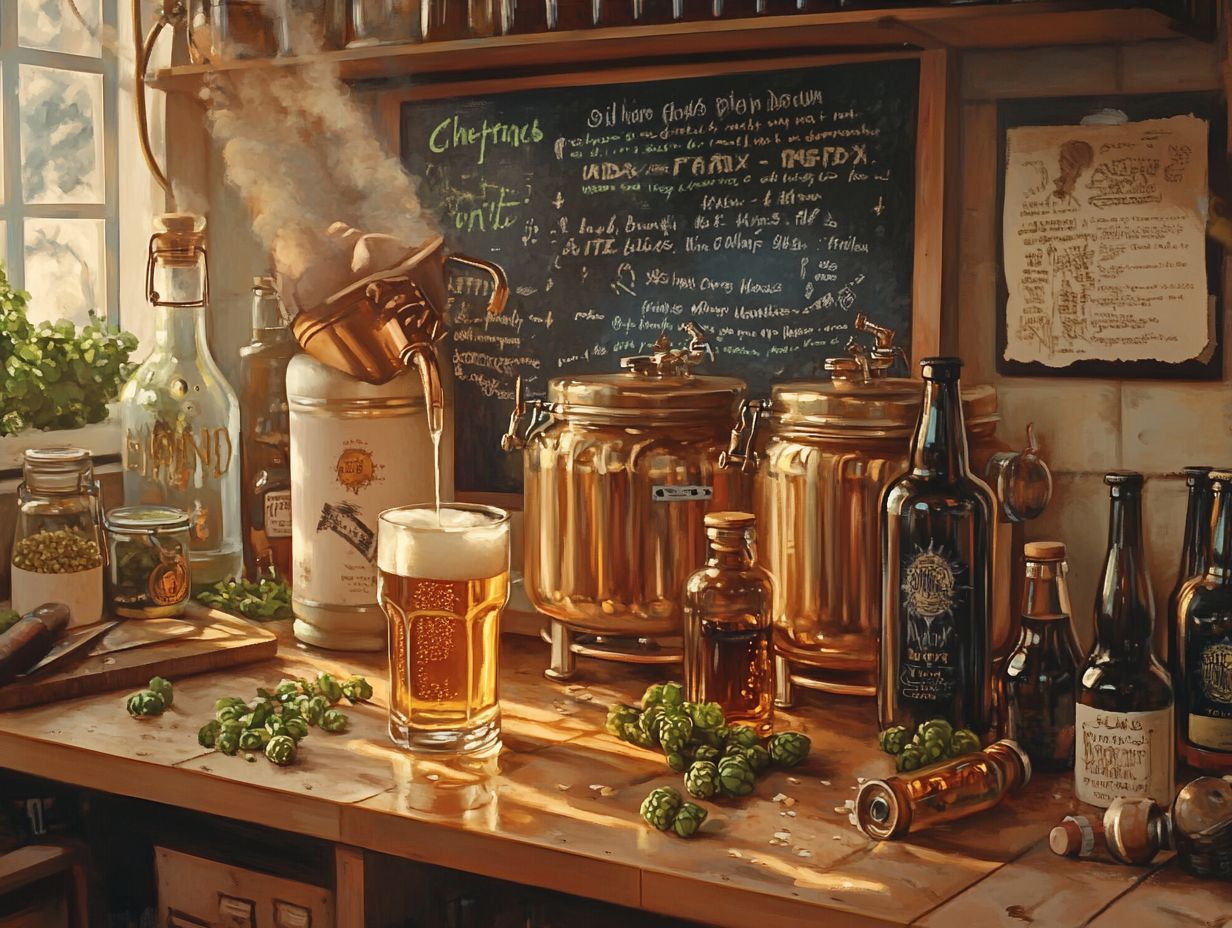
- Home brewing is for everyone! With the right equipment, such as a fermentation chamber, and knowledge, anyone can brew!
- Myth: Home brewing is illegal and time-consuming. The truth? It’s legal and can be a fun adventure!
- You don t need fancy gear or chemistry skills to brew great beer at home – there are simple and affordable methods available, like using dry yeast and liquid malt extracts.
What is Home Brewing?
Home brewing is more than just a hobby; it s a delightful blend of art and science that allows you to craft beer in the comfort of your own home. By carefully selecting quality ingredients like malt extract, hops, and yeast and mastering the nuances of fermentation temperature, you can produce beer that rivals commercial brands.
Using tools like an Inkbird temperature controller can aid in precision. Enthusiasts such as Mike Dalecki and Charlie Papazian have brought this rewarding pastime into the spotlight, highlighting the virtues of patience and a deep understanding of the brewing process. Key elements include conditioning during secondary fermentation, hop residue management, and debunking common myths about home brewing.
It s a richly rewarding yet approachable craft that offers a world of possibilities, catering to a wide array of styles from crisp American lagers to smooth Helles. Tools like a growler filler and brands like Craftmaster Stainless can enhance your brewing experience.
What Are the Most Common Myths About Home Brewing?
In the realm of home brewing, numerous myths linger that may discourage you from exploring this delightful and fulfilling craft. You might think that crafting high-quality beer at home demands costly equipment or expertise that only experienced brewers possess. Brands like Br losophy and their exBEERiment series show that even beginners can succeed.
However, the truth is that with the right guidance, anyone can navigate this process and create exceptional beers. Unraveling these misconceptions not only empowers you as an aspiring brewer but also enriches your brewing journey, inspiring creativity and experimentation with a variety of styles and techniques. Consider attending events like Homebrew Con for community support and expert tips.
Common Myths About Home Brewing
Myth 1: It’s Illegal to Brew Your Own Beer at Home
One of the most common myths that might hold you back as a would-be brewer is the notion that brewing your own beer at home is illegal. This misunderstanding often stems from confusion about the laws governing home brewing in various regions.
In reality, many places in the United States like California, Colorado, and Oregon have cultivated an atmosphere where home brewing is not just permitted; it’s actively encouraged. As an aspiring brewer, it’s wise for you to familiarize yourself with the specific regulations in your area. Don t miss out on this fantastic opportunity to brew at home! Some states limit how much you can brew, often allowing up to 200 gallons annually for personal consumption.
Always ensure your water is suitable for brewing by conducting regular water testing and potentially using a campden tablet to remove chlorine. Certain regions may also require permits or registration, especially if you plan to sell your home-brewed creations. Knowing these local laws lets you brew with confidence and enjoy this thrilling hobby!
Myth 2: You Need Expensive Equipment to Brew Beer at Home
Another common misconception is that you need to invest in expensive equipment to successfully brew beer at home, which can discourage you from diving into this rewarding hobby.
In reality, with just a few essential tools and budget-friendly options, even the most cost-conscious enthusiast can craft high-quality brews. Basic items like a fermentation vessel (the container used for brewing) and an airlock (a device that allows gases to escape during fermentation) are easily accessible at reasonable prices. You can also get creative and repurpose kitchen containers as DIY solutions.
For better extraction efficiency, consider upgrading to all-grain brewing systems when ready. Instead of splurging on fancy gadgets right from the start, focus on mastering the brewing process with simple ingredients and techniques. As your confidence and skills grow, you can gradually upgrade your setup and invest in specialized equipment when you feel ready. This approach not only keeps your journey economical but also makes it incredibly satisfying.
Myth 3: Brewing Beer at Home is Time-Consuming and Difficult

Many aspiring brewers often think that home brewing is an overwhelming and complicated endeavor, which can lead to unnecessary anxiety. However, understanding the home brewing timeline can illuminate this rewarding craft for you. Brands like New Belgium Brewing have shared their processes to make it more accessible.
Your journey begins with gathering ingredients, which can include everything from grains and hops to yeast and water. Once you have assembled and sanitized your equipment, the brewing process kicks off. This is followed by a crucial fermentation period, where patience becomes your greatest ally. During this time, the yeast works its magic, transforming sugars into alcohol and flavor. Ensuring fermentation control with a fermentation chamber can make the process smoother.
After fermentation, there s the conditioning phase, which requires some time to allow the flavors to meld and mature. By employing efficient techniques, such as controlling temperature and maintaining proper sanitation, you can significantly streamline the brewing process. This makes it not only manageable but also a truly enjoyable experience, no matter your level of expertise. Proper kegging can also enhance the final product.
Myth 4: Home Brewed Beer Always Tastes Bad
One of the most damaging myths within the home brewing community is that all home brewed beer tastes bad or is inferior to commercially produced options.
Countless home brewers have flipped this misconception on its head, crafting exquisite and flavorful beers that easily rival those from esteemed breweries. You’ll find numerous success stories from passionate individuals who have perfected their IPAs or created rich stouts that receive accolades from friends and family. The Brulosophy exBEERiment series highlights many of these remarkable brewers and their achievements.
These triumphs arise from a profound understanding of the brewing process. Selecting high-quality ingredients like fresh hops and malt is essential, coupled with meticulous attention to brewing techniques. By embracing proper temperature control and sanitation practices, you can avoid common pitfalls and elevate your brewing experience, resulting in exceptional flavors that hold their own against store-bought varieties.
Myth 5: Home Brewing is Only for Beer Enthusiasts
Home brewing isn’t just for die-hard beer enthusiasts; it s an inviting craft that welcomes everyone, no matter your background. From college students to retirees, anyone can enjoy this hobby.
Imagine a college student experimenting with bold flavors or a grandmother rediscovering her love for traditional recipes. These stories highlight how this hobby can unite people from all walks of life. Each brewing session is a unique opportunity to learn and unleash your creativity, allowing you to embrace the art of fermentation, even with no prior experience. With all-in-one systems and DIY solutions, the tools available can fit any skill level.
The brewing process is a treasure trove of knowledge. You can explore the fascinating science behind yeast, water chemistry, and the aging process, turning the experience into an adventure as much as a pleasure. This journey transforms casual hobbyists into passionate creators, fostering personal connections and shared experiences that enrich every step.
Myth 6: You Can’t Make High-Quality Beer at Home
A common misconception lingers that home brewers can’t craft high-quality beer that competes with commercial offerings, but this couldn’t be further from the truth. With a focus on ingredient quality, home brewers can make great beer.
The artistry of home brewing invites you to unleash your creativity and embark on a journey of experimentation that often yields remarkable results. The choice of ingredients is critical; selecting fresh, high-quality grains, hops, and yeast dramatically shapes the flavor of your final product. Utilizing products from Craftmaster Stainless can elevate your brewing game.
Attention to fermentation maintaining optimal temperatures and timing is crucial for the desired characteristics to flourish. Let’s not forget the importance of sanitation practices, essential for keeping unwanted bacteria at bay and safeguarding your brew’s integrity.
Diligent home brewers celebrate their success, often crafting bold flavors that impress and garner local and national awards. This showcases their remarkable ability to compete with established brands. Participating in events like Homebrew Con can provide valuable feedback and recognition.
Myth 7: Home Brewing is Cheaper Than Buying Beer
Many people assume that home brewing is a cost-effective alternative to purchasing beer, but the financial reality can be quite different for you. While initial costs may be high, improvements in extraction efficiency and bulk purchasing can offer savings over time.
The initial investment in equipment think fermenters, bottles, and brewing kits can be significant, often running into hundreds of dollars. You ll also need to consider the cost of ingredients like malt, hops, and yeast, along with ongoing expenses for cleaning supplies, temperature control, and any upgrades you might want to improve your brewing quality.
While you may find immense joy and satisfaction in crafting unique flavors, the savings compared to store-bought beer can quickly evaporate, especially if you tend to brew in small batches or lean towards premium ingredients. When you factor in the time and effort involved, you might discover that simply picking up a cold beer from the store is a more convenient and economical choice. Homebrewing, however, offers unmatched creativity and control over the final product.
Myth 8: You Can’t Experiment with Flavors and Styles When Home Brewing
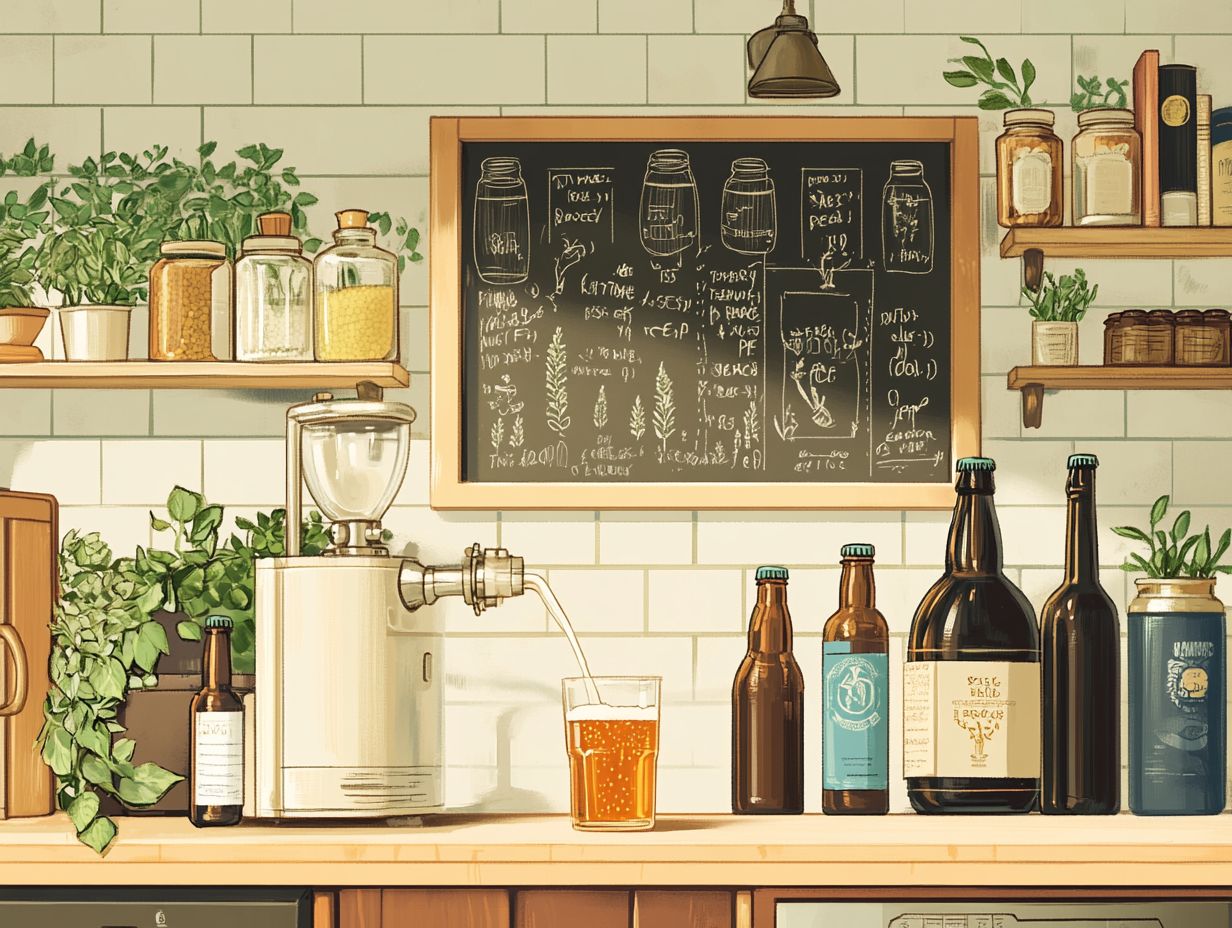
Another myth you might encounter is the notion that home brewing confines you to specific styles. In reality, it opens up a world of endless experimentation with flavors and brewing techniques. Myths around homebrewing often prevent newcomers from exploring its full potential.
By varying the types of hops, malts, and adjuncts, you can create brews that reflect the full spectrum of your imagination. For instance, incorporating unusual spices like coriander or citrus peels can add a refreshing twist to traditional recipes. Experimenting with different yeast strains can dramatically alter the profile of your brew, introducing fruity or earthy undertones that enhance the overall experience. Techniques like batch sparging and brew-in-a-bag can further expand your brewing capabilities.
It s wise to start with small batches when trying out new ingredients, allowing for adjustments without wasting precious resources. Proper conditioning and attention to fermentation temperature are key for achieving the best results.
With a spirit of creativity and some basic guidelines in mind, you’ll discover that the journey of home brewing can lead to delightful surprises and unique beverage experiences.
Myth 9: Home Brewing is Only for Men
There’s a common misconception that home brewing is a male-dominated activity, but you’ll quickly discover that this hobby thrives within a diverse and inclusive community that welcomes individuals of all genders, including enthusiasts like Mike Dalecki and Charlie Papazian.
In recent years, more and more women have entered the realm of home brewing, showcasing their creativity and passion for this craft. You might find them organizing workshops or hosting brewing events specifically aimed at women and marginalized groups, all part of an inspiring movement that is transforming the narrative about who can be a brewer. Notable events like Women s Brew Day and activities at New Belgium Brewing highlight this progress.
Initiatives like Women s Brew Day and events at local breweries not only offer valuable resources and networking opportunities but also celebrate the significant contributions of female brewers, encouraging others to take part in this vibrant community. Innovations from companies like Craftmaster Stainless and Inkbird help make homebrewing accessible to everyone.
As these stories unfold, they reveal the camaraderie and shared knowledge that make home brewing a welcoming and enriching space for everyone.
Myth 10: You Need to Be a Chemist to Understand the Brewing Process
Many aspiring brewers often worry that a deep background in chemistry is essential to grasp the brewing process, but this is a misconception that can be easily debunked. Understanding basic concepts like extraction efficiency and secondary fermentation can significantly ease the learning curve.
In reality, the art of brewing revolves more around a few fundamental concepts like fermentation, ingredient quality, and the balance of flavors. By understanding how yeast transforms sugars into alcohol and carbon dioxide, and how different malt and hop choices affect taste, anyone can start crafting their own brews without feeling daunted. Additionally, it’s important to debunk some common misconceptions about equipment; check out these 5 common home brewing equipment myths to enhance your brewing knowledge.
Using tools like a fermentation chamber and techniques such as kegging can further improve your brewing experience. Finding easy-to-understand resources can make your brewing journey exciting and fun! With a hands-on approach and a readiness to experiment, you can steadily build your confidence and skills in this delightful craft. For answers to common queries, resources such as the most common home brewing questions, the Brulosophy exBEERiment series, and attending homebrew cons can be incredibly helpful.
Frequently Asked Questions
What Are the Most Common Home Brewing Myths?
There are many myths surrounding home brewing, but some of the most common ones include:
Are darker beers stronger than lighter ones?
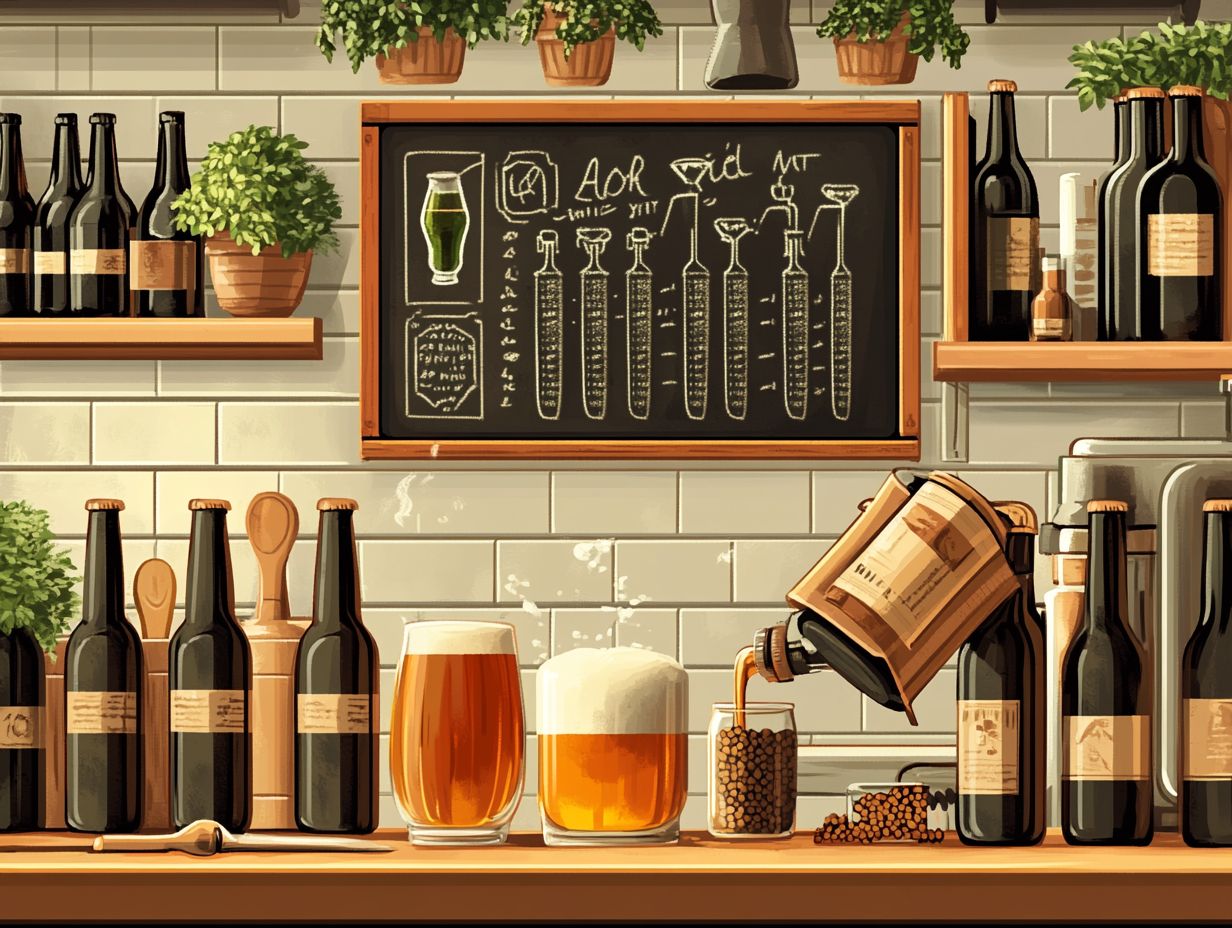
Contrary to popular belief, the color of a beer has no direct correlation to its strength. The alcohol content of a beer is determined by the amount of fermentable sugars used, not the color. Styles like American lager and Helles can be light in color but still pack a punch in flavor and alcohol content.
Does adding more hops make a beer more bitter?
While hops do contribute to the bitterness of a beer, the amount used does not necessarily determine the level of bitterness. Other factors such as the type of hops, when they are added, and the length of the brewing process also play a role. Managing hop residue can help achieve a cleaner taste.
Is it necessary to boil the entire batch of beer?
Many home brewers believe that boiling the entire batch of beer is necessary to sanitize it. However, boiling only a portion of the wort (unfermented beer) is enough to kill any harmful bacteria. Techniques like all-grain brewing and using a growler filler can further enhance your brewing process.
Can you use any type of water for home brewing?
Water quality is crucial in brewing, as it can greatly affect the taste of the final product. Using filtered or bottled water is recommended to ensure a clean and consistent flavor. Conducting water testing and using campden tablets can help remove chlorine and other impurities.
Is it necessary to use a secondary fermentation vessel?
While some brewers swear by using a secondary fermentation vessel, it is not always necessary. In fact, it can introduce more oxygen and increase the risk of contamination. It is best to research and decide based on the specific beer being brewed. Monitoring trub (the leftover yeast and hop debris) and practicing patience can yield better results.
Can you use any type of sugar for fermentation?
While many recipes call for plain white sugar, it is not recommended as it can result in a thinner and less flavorful beer. Instead, opt for specific brewing sugars, such as malt extract or corn sugar, to achieve the desired taste and body. Using liquid malt or dry yeast can further improve your brew.
Have more questions? Join the homebrewing community or share your thoughts below!

